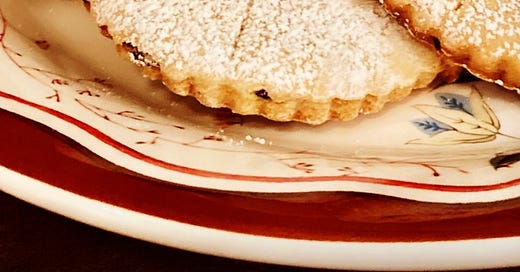Before there was Halloween, there was Samhain.
With Celtic roots, Samhain (“summers-end”) the ancient pagan festival, was marked by bonfires and sacrifices and thought to be the time when the boundaries between the living and the dead were at their thinnest — a liminal space, the threshold to the ‘other world.’
From T. Susan Chang for NPR:
Samhain was the festival of the dying sun god, and it’s dark power stayed potent even as the old ways faded. Samhain became All Souls’ Eve (Halloween) and All Souls’ Day. The practice of gathering around the bonfire waned. Instead, night visitors of the Dark Ages began to venture abroad, going house-to-house. If they were lucky they would be met with a plate of sweet and steaming soul cakes.
The article goes on to say that by the 8th Century, the cakes had been ‘sanctified’:
They were used to pay the beggars who came around on All Souls’ Eve and offered to say prayers for the family’s departed. One cake given, one soul saved…
I’ve linked to the entire article here: NPR.
During the 19th century there were also souler’s songs, including The Cheshire Soul Cake Song with the lyric:
A soul! A soul! A soul-cake
Please good Missus, a soul-cake!
The 1960’s folk group Peter, Paul and Mary covered the song and I’ve linked to their performance in Paris in 1965. It is, indeed, soulful and beautiful.
Here is the Link via You Tube (you may have to skip past an ad or two): Soul Cake Song (A Soalin’ )
A Recipe
Soul cakes are really more like biscuits/cookies or scones. The recipe I used includes raisins, ginger, cinnamon, nutmeg and cloves. This is a perfect cookie. It’s crisp, but has the chewy raisins along with the spices, but not an overpowering amount of them. The attached recipe also contains quite a bit of history.
If you make them your kitchen will smell delicious.
Recipe: Here
Some nice news and a follow-up to In the Night Kitchen
About a week ago I received the nice news that my piece In the Night Kitchen was featured in the latest edition of
Reads. I’d like to welcome all the many new subscribers who learned about this newsletter because of the feature, and, as always, thank all readers for being here.One of the really fun comments on the In the Night Kitchen post came from artist
who shares her words and art in her newsletter . From Vicki:I had Sendak for a children’s book illustration course at Parsons. He always complained about librarians.
I have so many questions, Vicki…
An inspiring comment that I believe Sendak would have loved came from
who writes From Katy:In a not-so-distant previous life, I was an elementary school librarian. We had two copies of this book (In the Night Kitchen) on our shelves and it was one of those books I was prepared to lose my job over if need be. I would have gone to battle for it. It was so important to me as a child, and children still love it so much. Thankfully, that battle never occurred, but I was READY!
And a delicious follow-up came from
of who made the hot milk cake and layered it. From Julia:It was fabulous — the texture of the cake is really good. I used the last of my peach and chamomile jam and cream to make it a bit fancy for a morning tea!
Julia has a cookbook out, so definitely visit
to learn more about her kitchen in Tasmania.Finally, one of the reasons I loved writing about In the Night Kitchen so much is that in the ‘way-back-when’ — over 30 years ago — I was a baker at Sarabeth’s Kitchen on 79th and Amsterdam in New York. On the weekends, I’d get to the bakery in the wee hours of the morning and with one other baker, make all of the muffins and pastries.
It was dark outside, we’d have the radio on to keep us moving and it always seemed like a small miracle that we got it all done before the crowds arrived.
I had great teachers in cooking school, but Sarabeth Levine was the person who REALLY taught me how to bake and for that I am forever grateful. And I still vividly and fondly remember my time in the night kitchen. ✨
Thanks for being here and take good care, everyone.
Jolene













A few more Halloween traditions that I wrote about last year for you at the link below, Jolene. Fid you know that the Scots also called this Nut Crack Night. Couples would whisper the name of their loved one represented by individual nuts—one for each of them— toss the nuts into the fire together, and then watch how they burn. If the nuts burn quietly together, then all is well. If they crack and burst? Well, I’ll leave that up to you to decide what that might mean. 😉
https://katemcdermott.substack.com/p/114-potpourri
Thank you for the lovely article, with the links, illustrations and of course the soul cakes. Thank you also for mentioning Samhain. So many of the old festivities were absorbed by Christianity, it is good to remember the nature focused festivals.